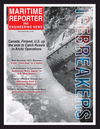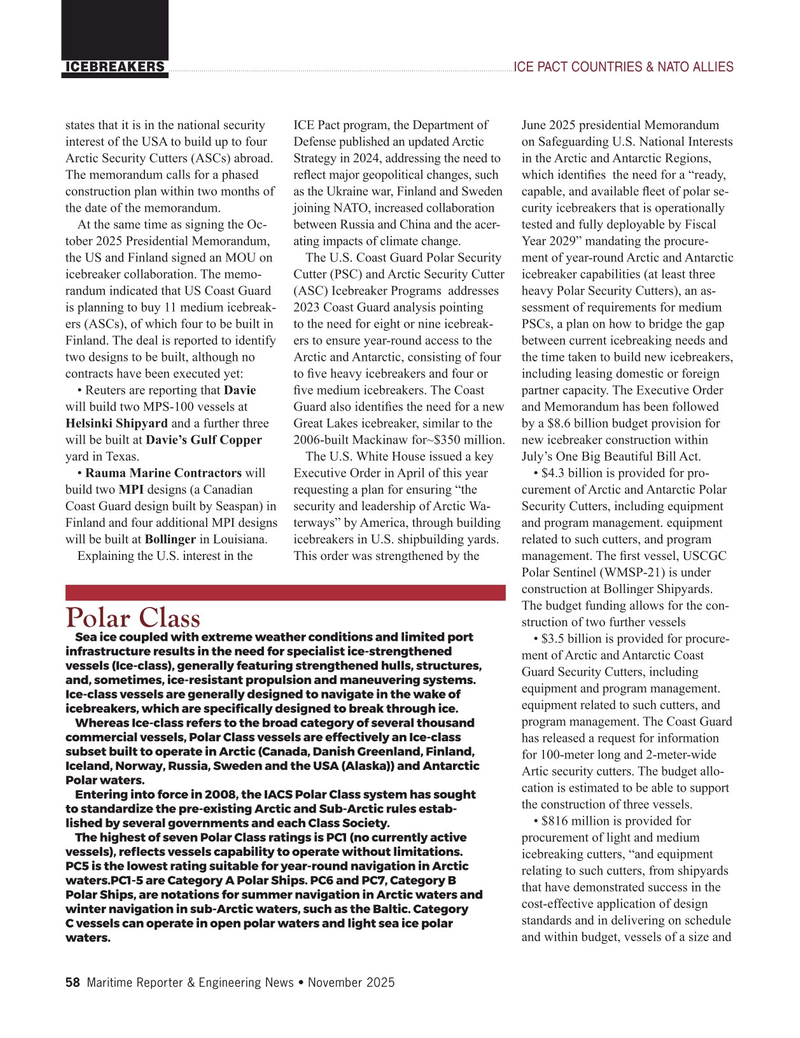
Page 58: of Maritime Reporter Magazine (November 2025)
Read this page in Pdf, Flash or Html5 edition of November 2025 Maritime Reporter Magazine
ICEBREAKERS ICE PACT COUNTRIES & NATO ALLIES states that it is in the national security ICE Pact program, the Department of June 2025 presidential Memorandum interest of the USA to build up to four Defense published an updated Arctic on Safeguarding U.S. National Interests
Arctic Security Cutters (ASCs) abroad. Strategy in 2024, addressing the need to in the Arctic and Antarctic Regions,
The memorandum calls for a phased re? ect major geopolitical changes, such which identi? es the need for a “ready, construction plan within two months of as the Ukraine war, Finland and Sweden capable, and available ? eet of polar se- the date of the memorandum. joining NATO, increased collaboration curity icebreakers that is operationally
At the same time as signing the Oc- between Russia and China and the acer- tested and fully deployable by Fiscal tober 2025 Presidential Memorandum, ating impacts of climate change. Year 2029” mandating the procure- the US and Finland signed an MOU on The U.S. Coast Guard Polar Security ment of year-round Arctic and Antarctic icebreaker collaboration. The memo- Cutter (PSC) and Arctic Security Cutter icebreaker capabilities (at least three randum indicated that US Coast Guard (ASC) Icebreaker Programs addresses heavy Polar Security Cutters), an as- is planning to buy 11 medium icebreak- 2023 Coast Guard analysis pointing sessment of requirements for medium ers (ASCs), of which four to be built in to the need for eight or nine icebreak- PSCs, a plan on how to bridge the gap
Finland. The deal is reported to identify ers to ensure year-round access to the between current icebreaking needs and two designs to be built, although no Arctic and Antarctic, consisting of four the time taken to build new icebreakers, contracts have been executed yet: to ? ve heavy icebreakers and four or including leasing domestic or foreign • Reuters are reporting that Davie ? ve medium icebreakers. The Coast partner capacity. The Executive Order will build two MPS-100 vessels at Guard also identi? es the need for a new and Memorandum has been followed
Helsinki Shipyard and a further three Great Lakes icebreaker, similar to the by a $8.6 billion budget provision for will be built at Davie’s Gulf Copper 2006-built Mackinaw for~$350 million. new icebreaker construction within yard in Texas. The U.S. White House issued a key July’s One Big Beautiful Bill Act.
• Rauma Marine Contractors will Executive Order in April of this year • $4.3 billion is provided for pro- build two MPI designs (a Canadian requesting a plan for ensuring “the curement of Arctic and Antarctic Polar
Coast Guard design built by Seaspan) in security and leadership of Arctic Wa- Security Cutters, including equipment
Finland and four additional MPI designs terways” by America, through building and program management. equipment will be built at Bollinger in Louisiana. icebreakers in U.S. shipbuilding yards. related to such cutters, and program
Explaining the U.S. interest in the This order was strengthened by the management. The ? rst vessel, USCGC
Polar Sentinel (WMSP-21) is under construction at Bollinger Shipyards.
The budget funding allows for the con- struction of two further vessels
Polar Class
Sea ice coupled with extreme weather conditions and limited port • $3.5 billion is provided for procure- infrastructure results in the need for specialist ice-strengthened ment of Arctic and Antarctic Coast vessels (Ice-class), generally featuring strengthened hulls, structures,
Guard Security Cutters, including and, sometimes, ice-resistant propulsion and maneuvering systems. equipment and program management.
Ice-class vessels are generally designed to navigate in the wake of equipment related to such cutters, and icebreakers, which are speci? cally designed to break through ice. program management. The Coast Guard
Whereas Ice-class refers to the broad category of several thousand commercial vessels, Polar Class vessels are effectively an Ice-class has released a request for information subset built to operate in Arctic (Canada, Danish Greenland, Finland, for 100-meter long and 2-meter-wide
Iceland, Norway, Russia, Sweden and the USA (Alaska)) and Antarctic
Artic security cutters. The budget allo-
Polar waters. cation is estimated to be able to support
Entering into force in 2008, the IACS Polar Class system has sought the construction of three vessels.
to standardize the pre-existing Arctic and Sub-Arctic rules estab- • $816 million is provided for lished by several governments and each Class Society.
The highest of seven Polar Class ratings is PC1 (no currently active procurement of light and medium vessels), re? ects vessels capability to operate without limitations. icebreaking cutters, “and equipment
PC5 is the lowest rating suitable for year-round navigation in Arctic relating to such cutters, from shipyards waters.PC1-5 are Category A Polar Ships. PC6 and PC7, Category B that have demonstrated success in the
Polar Ships, are notations for summer navigation in Arctic waters and cost-effective application of design winter navigation in sub-Arctic waters, such as the Baltic. Category standards and in delivering on schedule
C vessels can operate in open polar waters and light sea ice polar and within budget, vessels of a size and waters.
58 Maritime Reporter & Engineering News • November 2025
MR #11 (50-65).indd 58 MR #11 (50-65).indd 58 11/2/2025 9:48:50 PM11/2/2025 9:48:50 PM

 57
57

 59
59
